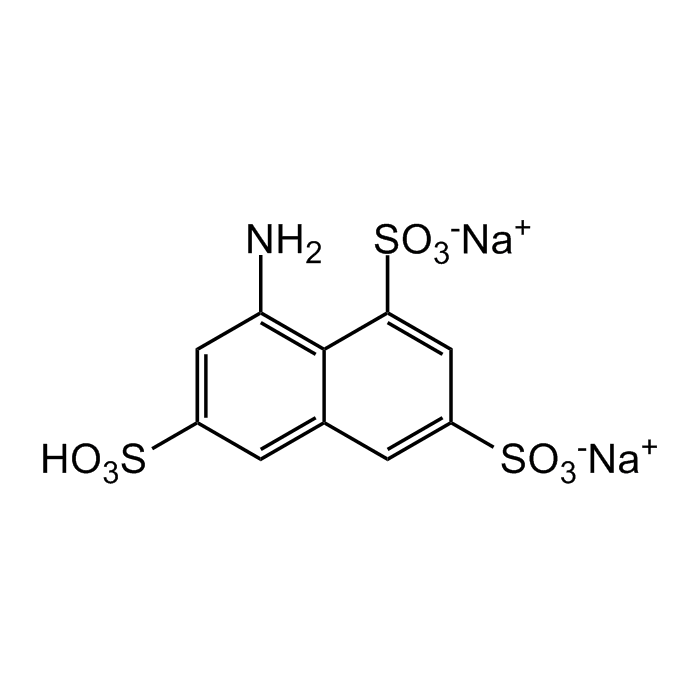Cookie Policy: This site uses cookies to improve your experience. You can find out more about our use of cookies in our Privacy Policy. By continuing to browse this site you agree to our use of cookies.
Chemodex
ANTS

| Product Details | |
|---|---|
| Synonyms | 8-Aminonaphthalene-1,3,6-trisulfonic acid disodium salt; Disodium 8-amino-1,3,6-naphthalenetrisulfonate |
| Product Type | Chemical |
| Properties | |
| Formula |
C10H7NNa2O9S3 |
| MW | 427.34 |
| CAS | 5398-34-5 |
| Purity Chemicals | ≥98% (HPLC) |
| Appearance | White to light brown powder. |
| Solubility | Soluble in water. |
| Identity | Determined by 1H-NMR. |
| Declaration | Manufactured by Chemodex. |
| Other Product Data |
Click here for Original Manufacturer Product Datasheet |
| InChi Key | KHJANRFXWPPWEL-UHFFFAOYSA-L |
| Smiles | NC1=C2C(C=C(S(=O)([O-])=O)C=C2S(=O)([O-])=O)=CC(S(=O)(O)=O)=C1.[Na+].[Na+] |
| Shipping and Handling | |
| Shipping | AMBIENT |
| Short Term Storage | +20°C |
| Long Term Storage | +20°C |
| Handling Advice |
Keep under inert gas. Very hygroscopic. |
| Use/Stability | Stable for at least 2 years after receipt when stored at RT. |
| Documents | |
| Product Specification Sheet | |
| Datasheet |
 Download PDF Download PDF |
ANTS is a highly negatively charged dye with an amino group that can be coupled to an aldehyde or ketone group to form an unstable Schiff base. The Schiff base is usually chemically reduced by sodium borohydride (NaBH4) or sodium cyanoborohydride (NaB(CN)H3) to form a stable linkage. This labeling technique has been widely used for the labeling and subsequent sequencing of oligosaccharides and glycoproteins. The negative charges of the dye facilitate the electrophoretic separation of the degradation products of carbohydrate polymers. The polyanionic dye ANTS is used together with the fluorescent cationic quencher DPX for membrane fusion studies or permeability assays. The mixture of ANTS-DPX is minimally fluorescent initially, but becomes increasingly more fluorescent upon dilution (i.e., membrane fusion or leakage). ANTS also is used as a neuronal tracer. ANTS has a relatively high Stokes shift in water, which sufficiently separates its emission from the majority of the autofluorescence of biological samples. Spectral Data: λex 356 nm; λem 512 nm in 0.1 M phosphate pH 7.0.
(1) H. Ellens, et al.; Biochemistry 23, 1532 (1984) | (2) S.S. Basu, et al.; Anal. Biochem. 222, 270 (1994) | (3) A. Klockow, et al.; Electrophoresis 17, 110 (1996) | (4) M. Cabanes-Macheteau, et al.; Electrophoresis 25, 8 (2004) | (5) K. Christopher, et al.; MethodsX 2, 174 (2015)





